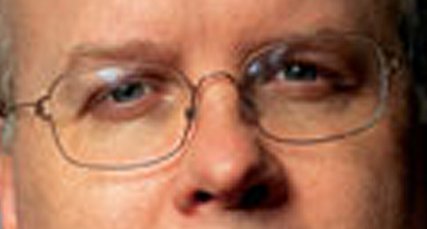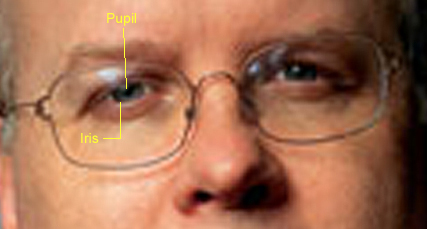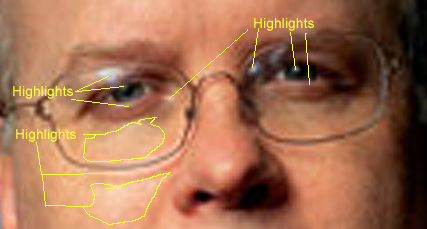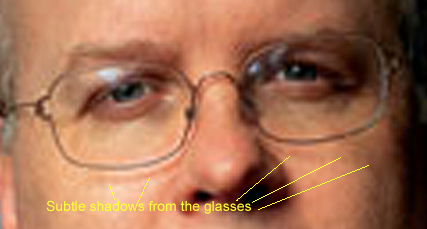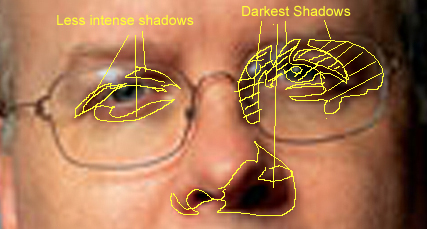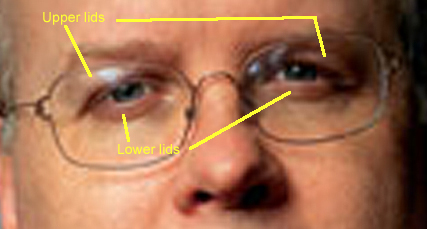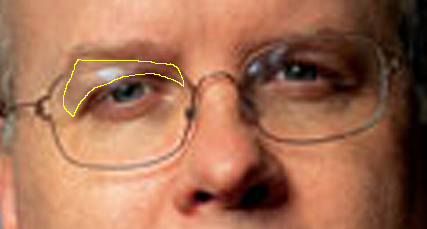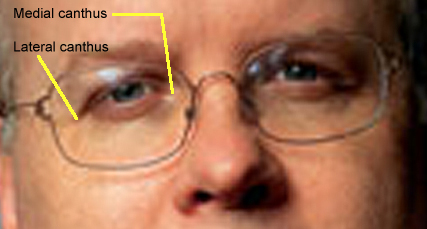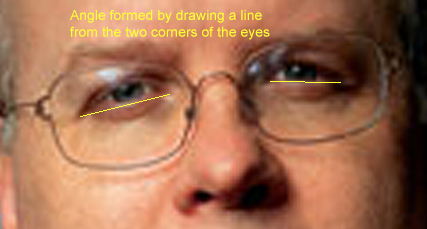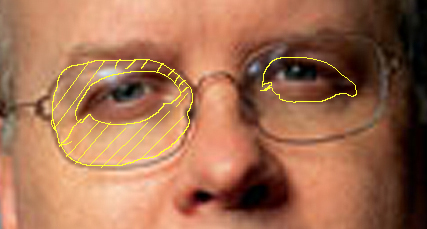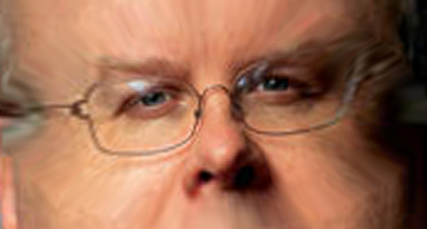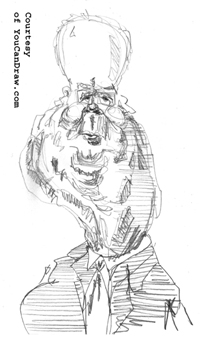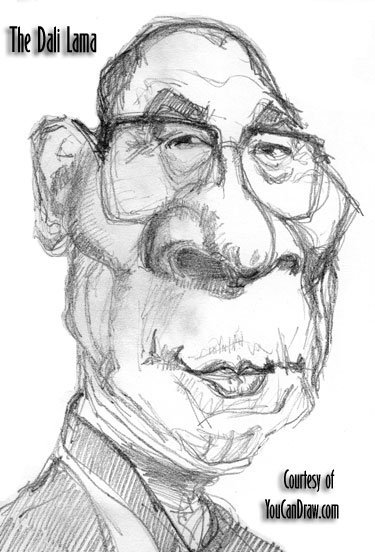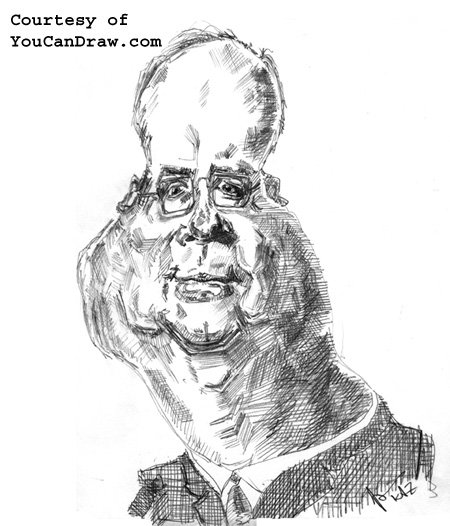|
Drawing EyesDrawing Eyes: Karl Rove's eyes in particular - reviewing the fundamentals of drawing and using your discoveries as fodder for either exaggeration or realistic portraits. |||||||||||||||||||||||||||||||||||||||||||||||||||||||||||||||||||||||||||||||||||||||||||||||||||||||||||||||||||||||||||||||||||||||||||||||||||||||||||||||||||||||||||||||||||||||||||| Caricature and Drawing Newsletter for December, 2005 OK, I said this last month: we're going to take a closer look at Mr. Rove's eyes. Not to get nit picky about his eyes, but rather to use what we know about the basic skills of drawing, about the anatomy of the eyes and to see if we can't pin down what's unique about Mr. Karl's eyes. First lets take a close up of just the area around the eyes:
Close up of Karl Rove's eyes Well, it's kind of hard to do that without also including at least part of the nose, the glasses, the eyebrows, eyelids, etc. And that's just fine because when you draw, recognizing relationships (e.g. how the nose squares up to the eyes, how the size of the iris compares to the nose, etc.), is a fundamental skill. If you take this much of the face (e.g. like the area around the eyes), and break it down into all it's elements, well we've started a short list, i.e. that list that began with eyes, eyelids, and glasses. To this list let's now add still more specific anatomy like the iris, pupils, upper and lower lids, the palpebral fold, the medial and lateral canthii (that's plural for "canthus", which is Latin for "corner"... i.e. the corners of the eyes), the angle formed by drawing a line from canthus to canthus...etc. [If you want in in-depth breakdown of how to build eyes from absolute scratch, and see one of the Internets most in-depth explanations on how to draw eyes: open up your Flash Lesson on Drawing Eyes or click right here and open the Lesson 12: Drawing Eyes lesson on-line.You can also go to the Archives and scroll down the far right hand column - then click on the Flash lesson for eyes.] So that's the starter anatomy list. Now let's review the 1) recognizing lines and edges, 2) perceiving positive shapes and negative spaces, 3) recognizing angles, proportions, perspective (in a word, relationships), 4) Light and shadow (You can view an outline of the fundamentals at these pages and in-depth in your sourcebook. What's the "sourcebook? Check out YouCanDraw.com .) All right, you hanging with me? Let's go right through this, I'll point out those things we just talked about about but it's up to you to start integrating it. Remember, everything -- and I mean absolutely everything that's discussed here is discussed in easy-reading, ultra in-depth detail in the YouCanDraw.com book. I'm going to be jumping around, so hang on! If you find yourself asking yourself "what the heck is he talking about now?", ask yourself which of the fundamental skills of drawing is he talking about - and how does it relate to the anatomy or shape we're discussing? OK. To begin, let's warm up on the pupil and iris. The pupil is the black spot -- actually the opening - in the middle of the iris. It's always black (unless you have a scar or cataract, then it'll be lighter in tone. Hope you never have to experience that for yourself.). The iris again is the colored part of the eye. In the picture just below here, find the pupil, the iris, and then look at where the iris runs into (or rather is covered) by the upper and lower lids:
The iris is round and is the colored (i.e. pigmented), part of the eye. Note where the pupil is Check out the other eye too -- the one that has no yellow lines pointing to it. Can you make out the pupil? I can't. That's because there's enough of a shadow there that it obscures the dark of the pupil. What does stand out is the highlight. Note too that the highlight doesn't necessarily land right on the pupil (though it often does): it can land on any other part of the eye. I mentioned the highlight on the pupil. Lets keep looking at highlights. In this next picture I've pointed out or outlined in yellow, areas of highlight or reflected light. Squint your eyes or back away far enough so that you can perceive these bright shapes yourself. If the lines around the highlights seem to obscure their edges, look at the photo above and see if you can't see them as separate shapes.
Try to recognize and perceive the areas of highlight as distinct shapes Note in any of these photos (since they're all the same photo :-) both the subtle highlight shapes and the shadows cast by the glasses. If you can see these, you can draw them. Look a little closer here for the the shadow cast by the glasses. They're subtle!
Those subtle shadows cast by the glasses And speaking of shadows, I've outlined still more shadow shapes. See, once you stop naming those different parts of anatomy, and you start seeing in terms of lines, edges, shapes, spaces, angles etc. (i.e. in terms of the fundamental elements of drawing) then the leap becomes available. Yes, I know it might sound a little contradictory, i.e. to be naming all these parts and then saying forget about the naming. But that's the main trick in drawing: divorce the words from your senses. Words and naming keep you stuck in the language driven part of the brain, which keeps you blocked from accessing the now-time, shape-proportion-color-line-and-edge deciphering function of the brain. So yes, let's actually get to the picture now. Voile!: a few of the darkest areas of shadow surrounding the eyes have been outlined in our digital highlighter (i.e. the yellow lines). Look at each outlined shape until you see it as distinct shapes:
Outlining the some of the darkest shadows around the eyes
We're going to take a small leap here. Let's outline some of the specific anatomy. For instance, let's look at the upper and lower lids. Can you look at that eyelid on the left (Mr. Rove's right) and see it as a distinct shape? Disregard the highlight right in the middle of it, and also disregard the the red tone imbued into the skin there. Concentrate on the shapes of those areas pointed out in this photo:
See if you can't see each section of anatomy as separate shapes I'll give you some help here. I'll outline the shape of that upper lid on the left. But even as I help you I want you to further notice a couple of things. For instance, notice where the upper frame of the glasses courses through it. And notice the angle at which it crosses through the lid (well, over the lid). And see if you can't envision the shape of the area bounded between the frame of the glasses on top and the line formed by the palpebral fold. OK, you're on:
A rough outline of the shape of the upper lid So what's the palpebral fold? It's the skin fold where a large portion of your upper eyelid gets hid, actually gets folded, when you open your eyes. See, I'm building an astute observer out of you even if you didn't want to be one :-). To be the best caricaturist, or the best portrait artist, you must take these seemingly tedious (but I think interesting, even fascinating), observational steps to really get great! Let's leap again. How to decide if you draw Mr. Rove's eyes as downsloping or catlike? Let's draw a line from corner to corner (I think we started doing that somewhere above...well, I'm getting back to that now :-). An imaginary line. Drawn from medial to lateral canthus. Let's see the canthii first :
Medial and lateral corners of the eyes (or canthii; singular: canthus); medial [Got those? Hey did you learn something? Canthus = corner. Canthii: well that's plural for canthus which is Latin for "corner" and in this case refers specifically to the corners of the eyes. So the next time you're going to go stand out on the corner and sing some harmonies with your buddies, you can tell your mom, dad, spouse, kids "hey, I'm going to go hang out on the canthus and sing some harmonies". Think they'll give you a funny look?] Like I mentioned a little bit ago, if you can see the edges, shadows and highlights along and around the glasses, ask yourself again the further question "what angle do any lines I see make with horizontal or vertical?" (e.g. what angles do the shadows cast by the frames of the glasses form with vertical and horizontal). And once you observe that, take again this further leap we keep swimming around: ask what angle might a line drawn from the medial canthus to the lateral canthus make? That is, what angle might a line drawn through the canthii make? I'll help you out a little:
Perceiving the imaginary line drawn from one corner of the eye to the other: this is a great way to decide how you should draw the eyes - as catlike with upturned corners (which women try to accentuate) or with eyes rotating downward at the outside corners. How would you draw Karl? Well the answer's right there in the pudding: downsloping. Now wasn't that easy? Let's take a step back. I want you to observe where the main shapes of the eye (i.e. the upper and lower lids, the eyeballs, the bulk of what we all recognize as "eye"), lands within the frame of the glasses. In my figuring, Mr. Roves eyes tend towards the upper, medial (towards the center of the body), part of the glasses. Can you see that in the next picture? Check it out:
The bulk of the eyes are framed by the rim of the glasses in the upper, medial part of the glasses So if you scroll back up to the top of the page and review the different spokes of the fundamental drawing skills, can you understand better now how we're applying them to understanding Karl Rove's face? And further, now that you know how to look at Karls face in terms of lines, edges, areas of light, areas of shadow, angles formed between parts -- all those fundamentals, can you imagine how you might exaggerate a caricature? (or draw a realistic portrait?) Cool! I hope that helped a little. Remember, all this is gone through in extreme detail in the Flash Lessons and in the book. Again, the point of this page is two-fold: 1) to do super quick application of the fundamentals of drawing and 2) to look for what's unique about Sir Karl's eyes. If, for instnce you compare them to say, the Dali Lama, you'll instantly see differences. But can you explain in words, in the language of drawing, what makes them different?
I applied the "spherize" function in Adobe Photoshop to start exaggerating the placement and Apply what's now fresh in your brain to drawing your own version of Karl's eyes, or just use it to study the caricatures below. You could look back at the November Newsletter too.
Can you see how the eyes -- and all those other things we discussed above are at work in these pictures? See November's newsletter for bigger pictures. Warmly,
Jeff Kasbohm PS -- have a great New Year! PSS -- As a bonus: Compare Mr. Rove's eyes / lids / eyebrows to this version of the Dali Lama. Also note the perspective at work in this "three-quarter" view of Mr. Lama versus the full front on view of Mr. Rove. Try this: Shape of the eyebrows: note the angle they form with the glasses, and note how they drop inside or outside the frames of the glasses.
Hey, here's an extra big Karl Rove picture I found floating around at the bottom of the page:
Kasbohm & Company's Drawing-Faces-and-Caricatures-Made-Easy.com © Copyright, All rights reserved 1997-2006
|
